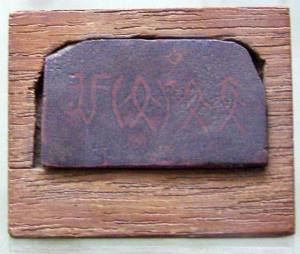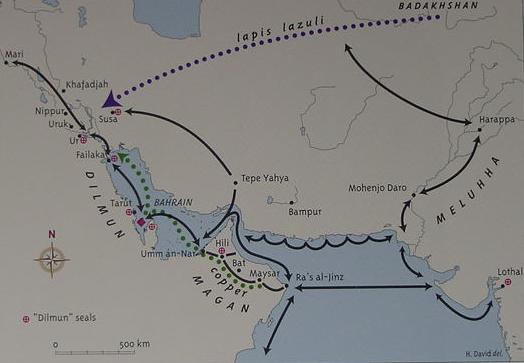Mirror: http://tinyurl.com/q5aqwjr
A copper plate from Mohenjo-daro with inscription demonstrates the connection between a pictorial motif and associated text of Indus Script inscriptions.
The copper plate kept in Lahore Museum has -- on the obverse --a hieroglyph-multiplex of rhinoceros + trough which is deciphered as 'Excellent implements of metalworkers guild'.
On the reverse of this plate is the following inscription (photo from Lahore Museum):
![]() Bronze plate with inscription. Sarasvati-Sindhu civilization Lahore Museum. (This is referred to as Copper plate on Indus Script Corpora).
Bronze plate with inscription. Sarasvati-Sindhu civilization Lahore Museum. (This is referred to as Copper plate on Indus Script Corpora).
On the obverse of this copper plate inscrition is a hierolyph-multiplex: rhinoceros PLUS trough:
kANDa 'rhinoceros' Rebus: khaNDa 'metal implements' pattar 'trough' Rebus: pattar 'metalworker (goldsmith) guild'.
The text of the inscription is supercargo, scribe documenting three types of ayas 'iron, metal':
Hieroglyph: fish 'aya' Rebus: aya 'iron' ayas 'metal'
Hieoglyph-multiplex: fish PLUS lid: aya 'fish' Rebus: aya 'iron, metal' adaren ‘lid’ Rebus: aduru 'native unsmelted metal'
Hieroglyph-multipled: fish PLUS notch: खांडा [ khāṇḍā ] m A jag, notch Rebus: ayaskhāṇḍa 'excellent implements: tools, pots and pans, metalware'
Hieroglyph-multiplex: fish PLUS oval as parenthesis circumscript PLUS horn: aya 'fish' Rebus: aya 'iron, metal' PLUS goTa 'round' Rebus: khoT 'ingot' koD 'horn' Rebus: koD 'workshop'
Hieroglyph: rim of narrow-necked jar: karava 'narrownecked jar' Rebus: kharva 'nidhi, karba 'iron'; karNaka 'rim of jar' Rebus: karNI 'supercargo', karNIka 'scribe'.
Thus, the text message is: Metalworker guild workshop supercargo scribed, ingot (of) native unsmelted metal, excellent metal implemets.
Second line on Texts 3415, 3318:
kanac 'corner' Rebus: kancu 'bronze'
koDi 'flag' Rebus: koD 'workshop'
sal 'splinter' Rebus: sal 'workshop'
meD 'body' Rebus: meD 'iron' PLUS koDa 'one' Rebus: koD 'workshop'
dula 'pair' Rebus: dul 'cast metal' PLUS khaNDa 'rectangle divisions' Rebus: khaNDa 'excellent metal implements' Thus the text message on this line is: excellent metal imlements (from) iron, bronze workshop
The contact area of the metalworkers extended beyond Persian Gulf into Mesopotamia as demonstrated by Dilmun seal finds with Indus Script from sites along the Persian Gulf and also on the banks of the doab: Tigris-Euphrates in Mesopotamia:
![]() Dilmun Seals: Persian Gulf find sites. "Dilmun is understood to embrace the eastern coastline of Arabia including the island of Failaka opposite Kuwait to the island of Bahrain (cf. p. 15. Harriet Crawford & Michael Rice, editors. Traces of Paradise, the Archaeology of Bahrain, 2500 B.C -300 A.D. London. Published by the Dilmun Committe for an exhibit from the Bahrain National Museum. Printed June 2000)."
Dilmun Seals: Persian Gulf find sites. "Dilmun is understood to embrace the eastern coastline of Arabia including the island of Failaka opposite Kuwait to the island of Bahrain (cf. p. 15. Harriet Crawford & Michael Rice, editors. Traces of Paradise, the Archaeology of Bahrain, 2500 B.C -300 A.D. London. Published by the Dilmun Committe for an exhibit from the Bahrain National Museum. Printed June 2000)."
http://www.bibleorigins.net/DilmunMaganMeluhhaBahrainFailakaCrawford.jpg
The language of the civilization is Prakritam which provides the spoken forms of Samskritam glosses related to metalwork. Many of these glosses are relatable to the Indo-European languages. It is suggested that Meluhha (Prakritam speakers) metalworkers had extensive contact with the region of the Indo-European languages in Eurasia as presented in the following map:
![]()
S. Kalyanaraman
Sarasvati Research Center
August 17, 2015
A copper plate from Mohenjo-daro with inscription demonstrates the connection between a pictorial motif and associated text of Indus Script inscriptions.
The copper plate kept in Lahore Museum has -- on the obverse --a hieroglyph-multiplex of rhinoceros + trough which is deciphered as 'Excellent implements of metalworkers guild'.
On the reverse of this plate is the following inscription (photo from Lahore Museum):
 Bronze plate with inscription. Sarasvati-Sindhu civilization Lahore Museum. (This is referred to as Copper plate on Indus Script Corpora).
Bronze plate with inscription. Sarasvati-Sindhu civilization Lahore Museum. (This is referred to as Copper plate on Indus Script Corpora).On the obverse of this copper plate inscrition is a hierolyph-multiplex: rhinoceros PLUS trough:
kANDa 'rhinoceros' Rebus: khaNDa 'metal implements' pattar 'trough' Rebus: pattar 'metalworker (goldsmith) guild'.
The text of the inscription is supercargo, scribe documenting three types of ayas 'iron, metal':
Hieroglyph: fish 'aya' Rebus: aya 'iron' ayas 'metal'
Hieoglyph-multiplex: fish PLUS lid: aya 'fish' Rebus: aya 'iron, metal' adaren ‘lid’ Rebus: aduru 'native unsmelted metal'
Hieroglyph-multipled: fish PLUS notch: खांडा [ khāṇḍā ] m A jag, notch Rebus: ayaskhāṇḍa 'excellent implements: tools, pots and pans, metalware'
Hieroglyph-multiplex: fish PLUS oval as parenthesis circumscript PLUS horn: aya 'fish' Rebus: aya 'iron, metal' PLUS goTa 'round' Rebus: khoT 'ingot' koD 'horn' Rebus: koD 'workshop'
Hieroglyph: rim of narrow-necked jar: karava 'narrownecked jar' Rebus: kharva 'nidhi, karba 'iron'; karNaka 'rim of jar' Rebus: karNI 'supercargo', karNIka 'scribe'.
Thus, the text message is: Metalworker guild workshop supercargo scribed, ingot (of) native unsmelted metal, excellent metal implemets.
Second line on Texts 3415, 3318:
kanac 'corner' Rebus: kancu 'bronze'
koDi 'flag' Rebus: koD 'workshop'
sal 'splinter' Rebus: sal 'workshop'
meD 'body' Rebus: meD 'iron' PLUS koDa 'one' Rebus: koD 'workshop'
dula 'pair' Rebus: dul 'cast metal' PLUS khaNDa 'rectangle divisions' Rebus: khaNDa 'excellent metal implements' Thus the text message on this line is: excellent metal imlements (from) iron, bronze workshop
The contact area of the metalworkers extended beyond Persian Gulf into Mesopotamia as demonstrated by Dilmun seal finds with Indus Script from sites along the Persian Gulf and also on the banks of the doab: Tigris-Euphrates in Mesopotamia:
 Dilmun Seals: Persian Gulf find sites. "Dilmun is understood to embrace the eastern coastline of Arabia including the island of Failaka opposite Kuwait to the island of Bahrain (cf. p. 15. Harriet Crawford & Michael Rice, editors. Traces of Paradise, the Archaeology of Bahrain, 2500 B.C -300 A.D. London. Published by the Dilmun Committe for an exhibit from the Bahrain National Museum. Printed June 2000)."
Dilmun Seals: Persian Gulf find sites. "Dilmun is understood to embrace the eastern coastline of Arabia including the island of Failaka opposite Kuwait to the island of Bahrain (cf. p. 15. Harriet Crawford & Michael Rice, editors. Traces of Paradise, the Archaeology of Bahrain, 2500 B.C -300 A.D. London. Published by the Dilmun Committe for an exhibit from the Bahrain National Museum. Printed June 2000)." http://www.bibleorigins.net/DilmunMaganMeluhhaBahrainFailakaCrawford.jpg
The language of the civilization is Prakritam which provides the spoken forms of Samskritam glosses related to metalwork. Many of these glosses are relatable to the Indo-European languages. It is suggested that Meluhha (Prakritam speakers) metalworkers had extensive contact with the region of the Indo-European languages in Eurasia as presented in the following map:

S. Kalyanaraman
Sarasvati Research Center
August 17, 2015

